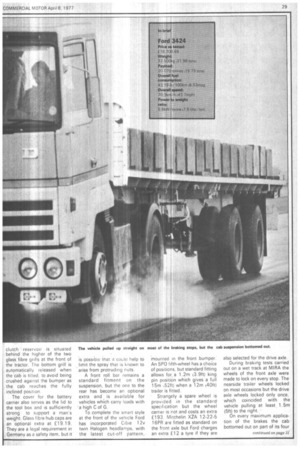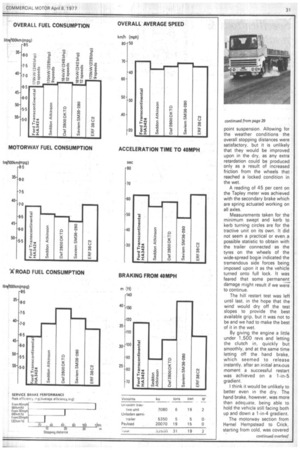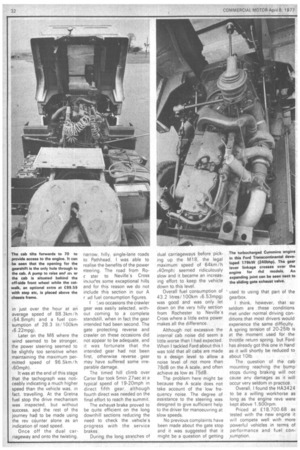seating position for the driver which is higher than can
Page 30

Page 31

Page 33

Page 34

If you've noticed an error in this article please click here to report it so we can fix it.
be found in any other European road going tractive unit. Highbacked cloth panelled seats provide . a high degree of comfort for both driver and mate.
The cab floor is flush with the door lips which makes it easy to remove all the dirt when cleaning the cab.
Instrumentation indicating the fuel level, trailer air pressure, tractive unit air pressure, water temperature, oil pressure, engine revolutions and road speed are all clearly marked and spread out in a line across the facia in front of the large steering wheel.
Two large lock-up boxes are provided in the facia in front of the mate's seat and extra storage spaces for books and maps are incorporated in the door panels.
A head panel above the windscreen extends the full width of the cab and includes air vents, more storage space, check switches for battery condition as well as oil and coolant levels which remove the need to make a physical inspection.
Ford has provided a pump operating a twin ram to raise and lower the cab to a 70 tilt, to allow access to the engine. A cold start facility is included for temperatures from zero down to —30 C in the form of a canister of ether which dispenses 3cc per start and has a
capacity for 300 operations.
The exhaust valve is of the sliding gate type which is combined with an expanding pipe joint to take up movement in the exhaust system.
Full flow filters are standard equipment and have a service life of 12,500 miles, whereas the large Farr air cleaner filters have an expected 160,000 km ,100,000-mile, life under normal running conditions For servicing purposes the engine has an under-cab starting facility. It is used only when the cab is in the raised position and the gearbox in neutral.
As 80 per cent of these vehicles are sold on the Contin ent a cross-shaft is included or British models to accommodate the revised gear-change leve position. A Behr viscostatic fan with a thermo strip inside thr hub, operates as the enginE temperature changes.
The manual oil dipstick which must be the longest ever is situated to the rear of the cal and can be withdrawn with th cab in the down position. Th radiator filler cap along with th clutch reservoir is situated behind the higher of the two glass fibre grills at the front of the tractor. The bottom grill is automatically released when the cab is tilted, to avoid being crushed against the bumper as the cab reaches the fully inclined position.
The cover for the battery carrier also serves as the lid to the tool box and is sufficiently strong to support a man's weight. Glass fibre hub caps are an optional extra at £19.19. They are a legal requirement in Germany as a safety item, but it is possible that it could help to . limit the spray that is known to arise from protruding nuts.
A front roll bar remains a standard fitment on the suspension, but the one to the rear has become an optional extra and . is available for vehicles which carry loads with 'a high C of G.
To complete the smart style at the front of the vehicle Ford has incorporated Cibie 12v twin Halogen headlamps, with the latest cut-off pattern, mounted in the front bumper. An SPO fifth-wheel has a choice of positions, but standard fitting allows for, a 1.2m 13.9ft) king pin position which gives a full 1 5m 52f•t) when a 12m k4Oft) trailer is fitted.
• Strangely a spare wheel is provided in the standard• specification but the wheel carrier is not and costs an extra E193. Mitchelin XZA 12-22-5 16PR are fitted as standard on the front axle but Ford charges an extra £12 a tyre if they are also selected for the drive axle.
During braking tests carried out on a wet track at MIRA the wheels of the front axle were made to lock on every stop. The nearside trailer wheels locked on most occasions but the drive axle wheels locked only once, which coincided with the vehicle pulling at least. 1.5m (5ft) to the right.
On every maximum application of the brakes the cab bottomed out on part of its four point suspension. Allowing for the weather conditions the overall stopping distances were satisfactory, but it is unlikely that they would be improved upon in the dry, as any extra retardation could be produced only as a result of increased friction from the wheels that , reached a locked condition in the wet.
A reading of 45 per cent on the Tapley meter was achieved with the secondary brake which are spring actuated working on all axles.
Measurements taken for the minimum swept and kerb to kerb turning circles are for the tractive unit on its own. It did not seem a practical or even a possible statistic to obtain with the trailer connected as the tyres on the wheels of the wide-spread bogie indicated the tremendous side forces being imposed upon it as the vehicle turned onto full lock. It was feared that some permanent damage might result if we were to continue.
The hill restart test was left until last, in the hope that the wind would dry off the test slopes to provide the best available grip, but it was not to be and we had to make the best of it in the wet.
By giving the engine a little under 1,500 revs and letting the clutch in, quickly but smoothly, and at the same time letting off the hand brake, which seemed to release instantly, after an initial anxious moment a successful restart was achieved on a 1-in-5 gradient.
I think it would be unlikely to better even in the dry. The hand brake, however, was more than adequate, being able to hold the vehicle still facing both up and down a 1-in-4 gradient.
The motorway section from Hemel Hempstead to Crick, starting from cold, was covered in just over the hour at an average speed of 88.3km /h i54.8mph) and a fuel consumption of 28.3 lit/ 100km t6.22mpg).
Later on the M6 where the wind seemed to be stronger, the power steering seemed to be slightly too sensitive when maintaining the maximum permitted speed of 96_5km /h i6Omph).
It was at the end of this stage that the tachograph was noticeably indicating a much higher speed than the vehicle was, in fact, travelling. At the Gretna fuel stop the drive mechanism was inspected, but without success, and the rest of the journey had to be made using the rev counter alone as an indication of road speed.
Once off the dual carriageway and onto the twisting, narrow, hilly, single-lane roads to Pathhead, I was able to realise the benefits of the power steering. The road from Roc ster to Neville's Cross induc'es some exceptional hills and for this reason we do not include this section in our A r ad fuel consumption figures.
( :No occasions the crawler gear was easily selected, without coming to a complete standstill, when in fact the gear intended had been second. The gate protecting reverse and crawler on these occasions did not appear to be adequate, and it was fortunate that the intended gear had not been first, otherwise reverse gear may have suffered some irreparable damage.
The timed hill climb over Carter Bar took 5min 27sec at a typical speed of 19-20mph in direct fifth gear, although fourth direct was needed on the final effort to reach the summit,.
The exhaust brake proved to be quite efficient on the long downhill sections reducing the need to check the vehicle's progress vvrth the service brakes.
During the long stretches of
dual carriageways before picking up the M18, the legal maximum speed of 64km / h 140mph) seemed ridiculously slow and it became an increasing effort to keep the vehicle down to this level.
Overall fuel consumption of 43.2 litres/ 100km 16.53mpg) was good and was only let down on the very hilly section from Rochester to Neville's Cross where a little extra power makes all the difference.
Although not excessive the internal cab noise did seem a little worse than I had expected. When I tackled Ford about this I was told that all cabs are made to a design level to allow a noise level of not more than 78dB on the A scale, and often achieve as low as 7.5dB.
The problem here might be because the A scale does not take account of the low frequency noise. The degree of assistance to the steering was designed to give sufficient help to the driver for manoeuvring at slow speeds.
No previous complaints have been made about the gate stop and it was suggested that it might be a question of getting used to using that part of the gearbox.
I think, however, that so seldom are these conditions met under normal driving conditions that most drivers would experience the same difficulty. A spring tension of 20-25Ib is at the moment used for the throttle return spring, but .Ford has already got this one in hand as it will shortly be reduced to. about bib.
The question of the cab mounting reaching the bump stops during braking will not cause any damages as it will occur very seldom in practice, Overall, I found the HA3424 to be a willing workhorse as long as the engine revs were kept above 1,500rpm.
Priced at E18,700.68 as tested with the new engine it will compete well with more powerful vehicles in terms of performance and fuel consumption,




























































































